Aldwell-Schachter Chapter 7
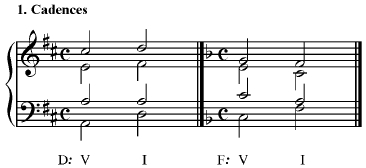
Perfect Authentic Cadence (PAC).
The cadence moves from V to I, and ends with ^1 in the soprano.
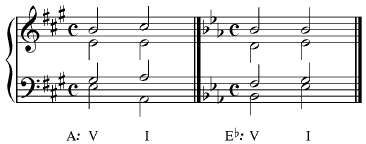
Imperfect Authentic Cadence (IAC).
The cadence moves from V to I, and ends with either ^3 or ^5 in the soprano.
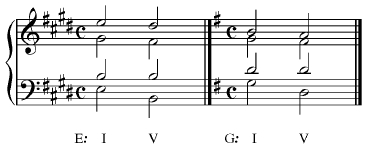
Semicadences (I-V) featuring a descending soprano line.
Note that there is no distinction with semicadences between perfect and imperfect.
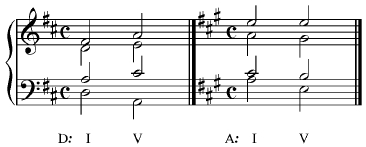
Semicadences featuring soprano lines which either ascend or stay put.
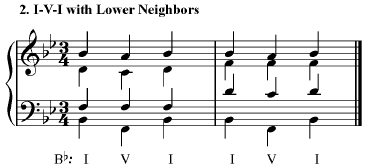
Lower neighbor figure in the soprano, starting on ^1. Note that the common tone is kept in the same voice throughout. In measure 1 the common tone is in the tenor; in measure 2 it is in the alto. Note also that the voice-leading in these two measures is essentially identical; the alto and tenor voices have changed their roles, nothing else.
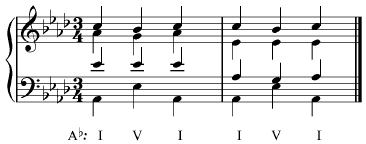
Lower neighbor figure in the soprano, starting on ^3. The voice leading is the same as in the previous example: the common tone is kept throughout, and the inner voices simply exchange functions from first to second measure.
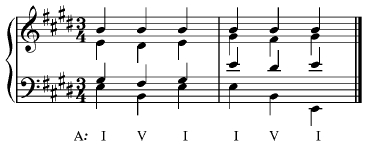
The common tone may be retained in the soprano rather than in an inner voice. Note that the bass lines are demonstrating a bit more freedom — the octave position of ^1 or ^5 can be more or less anything you want as long as the leaps are not excessive.
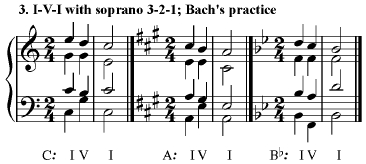
^3-^2-^1 in the soprano sets nicely with I-V-I. Note, however, that it necessitates an incomplete I if the leading tone is resolved to ^1. However, the leading tone can be resolved to either ^5 (example 2) or ^3 (example 3) in this particular figure — that is, with a ^2-^1 motion in the soprano. Bach is fairly consistent in this practice, in that he allows himself a complete tonic when the soprano moves ^2-^1. (It works because the leading tone is consonant with both outer voices.)
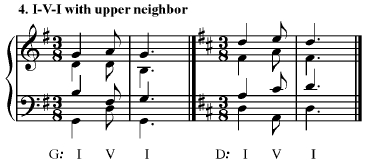
The soprano moving as an upper neighbor. Here I am writing an incomplete tonic; this would be perfect acceptable especially in an interior cadence rather than in a final cadence.

This is essentially the same progression as above, with the soprano and tenor voices exchanged.
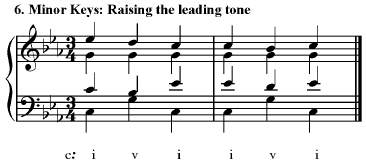
It is critical to raise the leading tone in minor when setting the dominant chord! Otherwise you are going to sound modal — which isn't bad in and of itself, but is not 18th century practice. This is all the more reason to remember the rasied leading tone in your analysis; if you remember to indicate it in one place, you may well remember to indicate it in another.
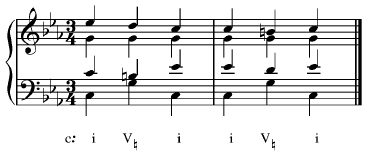
Here is the same progression with the leading tone repaired. Note in the first measure that there is a leap of a diminished fourth; this is the result of using the Bachian practice outlined above and is perfectly acceptable.
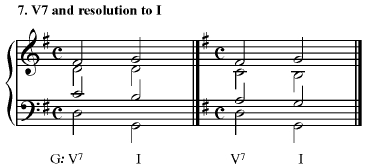
Because V7 contains ^4 (the seventh of the V7), which has a strong tendency to ^3 — and because the 7th of a seventh chord demands downwards stepwise resolution, ^4 MUST be resolved to ^3 when moving from V7 to I. This results in this situation: either V7 will be incomplete, or I will be incomplete, but both chords cannot be complete.
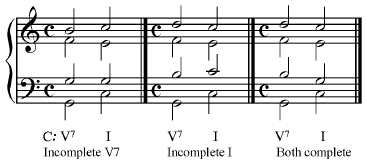
Three versions of the same progression (a perfect authentic cadence employing V7-I). In measure 1, an incomplete V7 leads to a complete I; in measure 2, a complete V7 leads to an incomplete I. However, in measure 3, I have invoked Bach's practice (since the soprano is moving ^2 -^1) and thus both chords may be complete. This is Bach's favored practice in his chorales, and definitely a good practice to adopt.
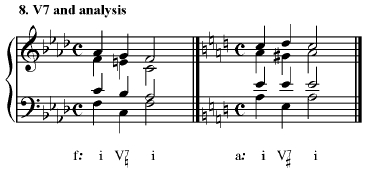
Just as with V, it is critical to raise the leading tone in the minor mode when writing V7. The analyses in these four examples demonstrate correct notation.
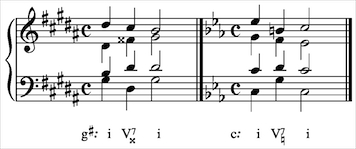
In the first example, note the slightly unorthodox voicing in which the fifth of the initial tonic is doubled. That helps to avoid a parallel fifth moving to a diminished fifth in the second chord -- not technically forbidden, but best avoided if possible.
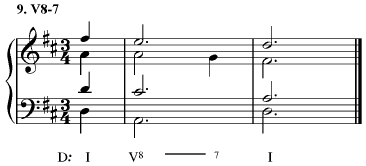
When V moves to V7, normally it is the doubled root (notated as '8' in the analysis) that moves to V7. In this case, the notation "V8-7" is preferable to the relatively clumsy "V - V7".
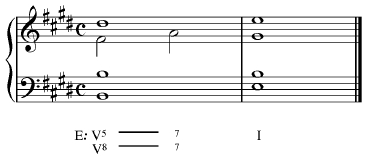
That same analytical notation is kept, even if the motion to the seventh is from the fifth above the bass, as in this example. Although technically speaking the analysis should read: "V5-7", in practice it is figured as "V8-7" anyway.